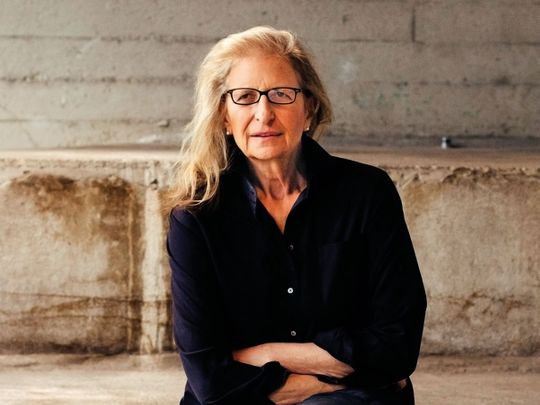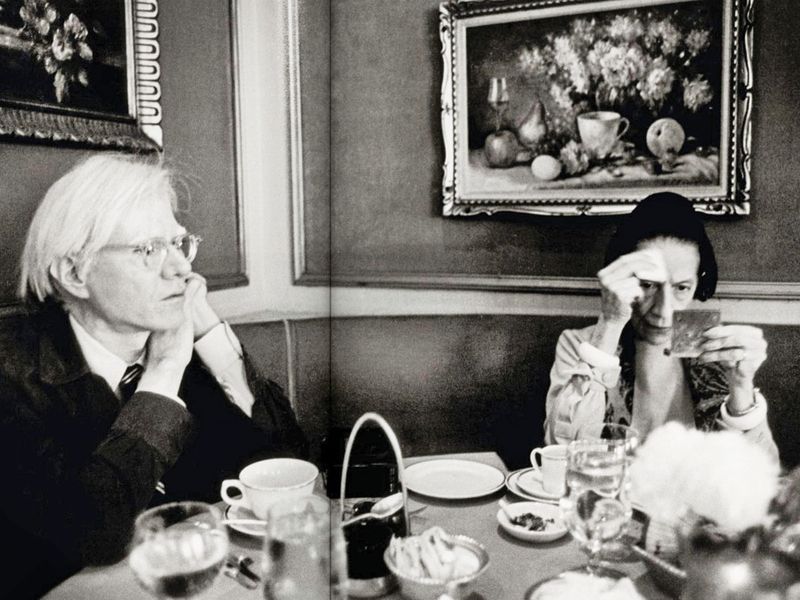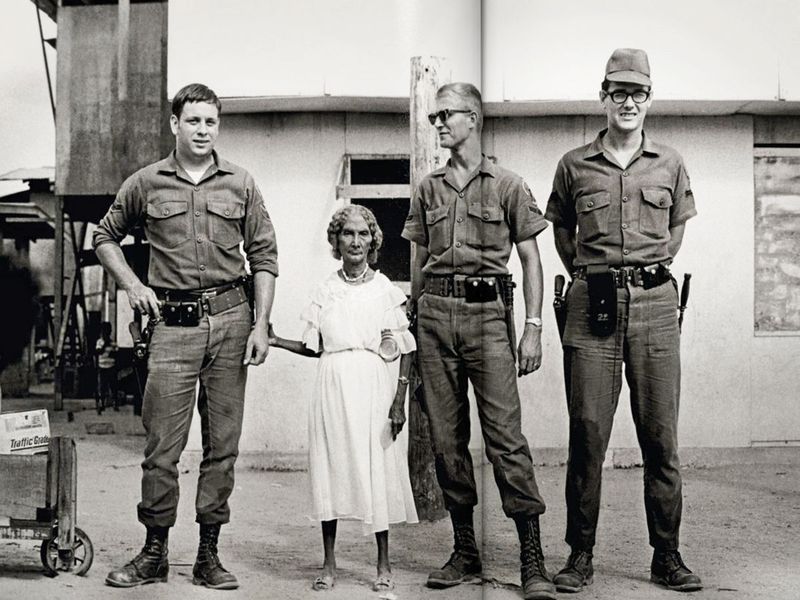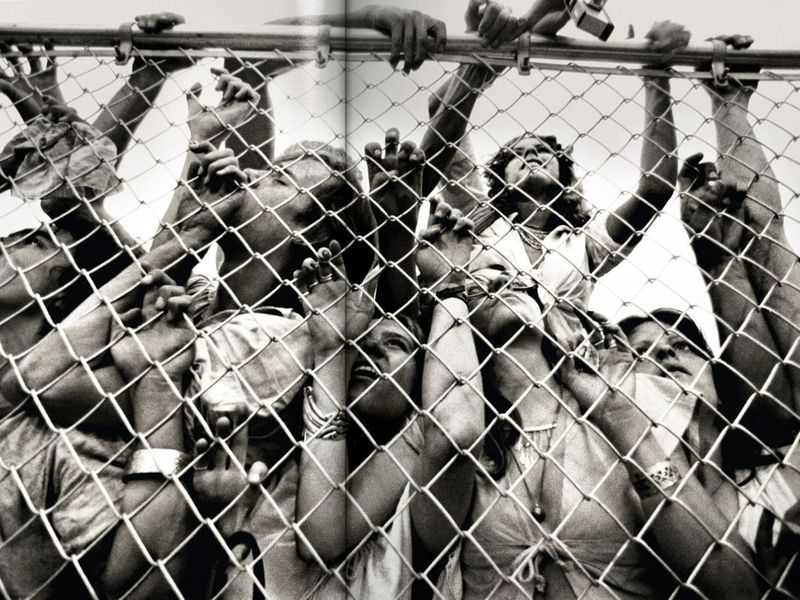
When Annie Leibovitz was starting out as a photographer in San Francisco, she would toss her camera equipment into the back of her 1963 Porsche Cabriolet convertible and tear off to Los Angeles on Highway 5.
“You used to be able to go 80, 90, 100 miles per hour — it was a straightaway,” Leibovitz recalled in a recent interview at her Manhattan studio, wearing black and her signature glasses. “You would just get on it and drive like a bat out of hell.”
When a national maximum limit of 55 mph was introduced in 1974, Leibovitz started racking up speeding tickets. And each time a police officer approached her car, she would photograph him with her Polaroid SX-70. “I took two,” she said, “one for them and one for me.”
Those Polaroids are among the more than 4,000 images from her early years that fill an exhibition of Leibovitz’s work at Hauser & Wirth, the first show with that gallery for the photographer, who turns 70 in October.

“There is rarely somebody who has captured America like her in terms of her perception of the 20th century,” said Marc Payot, the gallery’s partner and vice-president. “This show is really her beginning as a photographer and developing her language.”
The exhibition — Annie Leibovitz. The Early Years, 1970-1983: Archive Project No. 1 — comes as photographers are increasingly promoted as artists by galleries.David Zwirner, for example, in 2016 took on William Eggleston, and in 2018 began sharing representation of the Diane Arbus estate with Fraenkel Gallery in San Francisco.
“Photography has historically been seen by many as the poor, little cousin of the art world,” said Joshua Holdeman, a New York-based adviser who specialises in 20th-century art and photography. “Most top galleries are now realising that photography is a cultural product just like painting and sculpture, and their programs are reflecting this.”
I have always thought of my work as art. I really thought I could take pictures in this landscape of magazines. Is it easy? No. Are there compromises? Absolutely. Are there five to 10 great photographs a year that I get out of it? Absolutely.
Having seen the 2017 exhibition of Leibovitz’s early body of work at the LUMA Foundation in Arles, France, Payot said he felt strongly that he wanted to bring that show to the United States, where Leibovitz deserved to be contextualised “with the greats of the century — painters, sculptors.”
“She is perceived as a photographer, but not really in the context of art,” he added.
Leibovitz was actually formally trained at the San Francisco Art Institute where, she said, she studied “classic Robert Frank and Cartier-Bresson,” a style she applied to her photojournalism for Rolling Stone magazine and then Vanity Fair.
“I have always thought of my work as art,” she said. “I really thought I could take pictures in this landscape of magazines. Is it easy? No. Are there compromises? Absolutely. Are there five to 10 great photographs a year that I get out of it? Absolutely.”

Leibovitz said she was well aware that magazine photographers had historically not been respected as artists. “I look at what Avedon had to go through — he was made to feel somewhat ashamed of his magazine work,” she said, referring to Richard Avedon, who was often dismissed by art critics because he began his career as a fashion photographer. “You just have to wait till you’re dead — it’ll be fine,” Leibovitz said, adding, “I know who I am.”
The exhibition takes up 24 walls of the gallery’s sprawling space in a former flour mill in downtown Los Angeles that opened in 2016. The images encompass the first 14 years of Leibovitz’s career, when she was shooting performers such as Rod Stewart, Loretta Lynn, Elton John and Aretha Franklin, and public officials like Hubert H. Humphrey, Henry Kissinger and Edward Kennedy. To move through the show is to be immersed in the pivotal era between 1970 and 1983.
“The idea was to be overwhelmed,” Leibovitz said, “not to sit there and look at each photograph, but to get this idea that it doesn’t stop. It goes on.”
In preparing for the show in Arles with Maja Hoffmann, LUMA Foundation’s founder, Leibovitz said she had spent more than two years looking at every single contact sheet from that period and doing a very liberal edit.

“I had no idea what I was opening up, this Pandora’s box,” Leibovitz said. “I wish I were Cartier-Bresson — the decisive moment. But it’s not like individual photographs stand out at you. It’s really like a small film. If you start to look for the picture, you get bogged down. So I started to just pull things out — anything I was interested in.”
The archive she created adds up to a chapter of her life, a moment in time when she was capturing major cultural moments like Apollo 17, Nasa’s last manned mission to the moon; Rolling Stones tours; the 1972 presidential campaign with journalists Hunter Thompson and Timothy Crouse — which resulted in Crouse’s seminal book, The Boys on The Bus; and the liftoff of Richard Nixon’s helicopter from the White House lawn after he resigned.
Rolling Stone was holding about 10 pages for Thompson’s Nixon story, but Thompson had writer’s block, “so they took my pictures and they blew them up,” Leibovitz said. “It was the first time the magazine used photographs to tell a story.”
The exhibition, most of which is in black and white, offers a window into the development of a young photographer — hungry, driven and consumed.

“It is the story of a young girl photographer going out and learning how to become a photographer,” Leibovitz said. “I really did see it as a way to instruct young photographers. You’re meant to walk through it; you’re not meant to sit there and try to understand it.”
“When I was younger, I was afraid of being so obsessed and so crazed,” she continued. “I just want all these younger photographers to know: Eventually you do come out of it.”
She had not spent time with these images since her first book, Photographs Annie Leibovitz 1970-1990, whose cover features the now-famous shot of John Lennon curled naked into a clothed Yoko Ono. Revisiting that chapter of her life was, Leibovitz said, “very emotional.”
“I did not know what I was doing,” she said. “But I just let it roll. I still don’t know if it makes any sense.”
The images at Hauser & Wirth were produced on an Epson printer and then push-pinned to the wall. None are for sale.
“They are cheap copies, so it’s not something you can keep,” Payot said. “It has a very raw feeling, and it is pinned on a board through the paper, so it has this studio feeling. It’s not the prestigious gelatin silver print, classical frame photography. It’s really very close to her creation at that time.”
Asked whether this collaboration might result in the gallery’s representation of Leibovitz, Payot said: “It is a first project. I hope there will be others.”
Leibovitz said presenting the show in Los Angeles seemed especially appropriate, given her beginnings — kind of like coming home. “It’s a California story, so it feels so good to have it in California,” she said. “This work was born there.”
–New York Times News Service
Annie Leibovitz. The Early Years, 1970-1983: Archive Project No. 1 will run at Hauser & Wirth in Los Angeles until April 14.












